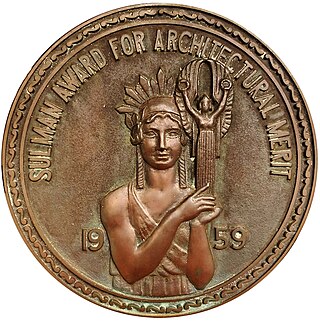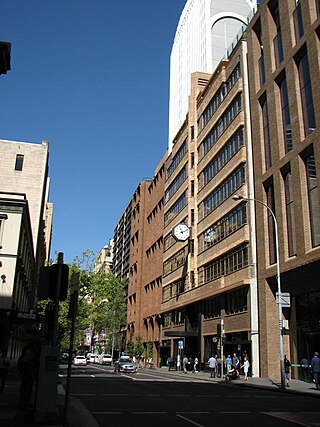
Hyde Park, Sydney, is an urban park, of 16.2-hectare (40-acre), located in the central business district of Sydney, in the City of Sydney local government area of New South Wales, Australia. It is the oldest public parkland in Australia. Hyde Park is on the eastern fringe of the Sydney city centre and is approximately rectangular in shape, being squared at the southern end and rounded at the northern end. It is bordered on the west by Elizabeth Street, on the east by College Street, on the north by St James Road and Prince Albert Road and on the south by Liverpool Street.

George Rayner Hoff was a British-born sculptor who mainly worked in Australia. He fought in World War I and is chiefly known for his war memorial work, particularly the sculptures on the Anzac War Memorial in Sydney.

The Anzac Memorial is a heritage-listed war memorial, museum and monument located in Hyde Park South near Liverpool Street in the CBD of Sydney, Australia. The Art Deco monument was designed by C. Bruce Dellit, with the exterior adorned with monumental figural reliefs and sculptures by Rayner Hoff, and built from 1932 to 1934 by Kell & Rigby. This state-owned property was added to the New South Wales State Heritage Register on 23 April 2010.

Medal designer: George Rayner Hoff (1894-1937), sculptor and teacher. Famed for his sculptures in Sydney's Anzac Memorial.
Australian non-residential architectural styles are a set of Australian architectural styles that apply to buildings used for purposes other than residence and have been around only since the first colonial government buildings of early European settlement of Australia in 1788.

The National War Memorial (South Australia) is a monument on the north edge of the city centre of Adelaide, South Australia that commemorates South Australians who served in the First World War and those who gave their lives. It was opened in 1931. The memorial is on the corner of North Terrace and Kintore Avenue, next to the grounds of Government House. Observances are held at the site throughout the year, with major services on Anzac Day (25 April) and Remembrance Day (11 November).

Emil Lawrence Sodersten was an Australian architect active in the second quarter of the 20th century. His work encompassed the Australian architectural styles of Art Deco and Functionalist & Moderne. His design for the Australian War Memorial was "the first national architectural monument in Australia". The Australian Institute of Architects presents the Emil Sodersten Interior Architecture Award annually in his honour.
Lipson & Kaad was an Australian architectural practice working in Sydney from the 1930s until the 1960s. The partners were Samuel Lipson (1901–1995) and Peter Kaad (1898–1967). In Migrant architects practising modern architecture Rebecca Hawcroft states that "the firm became one of the most successful and prominent in the period and designed several of the era’s best buildings". Both partners were influence by the Amsterdam School and in particular the work of Willem Dudok.

Peter Kaad (1898–1967) was an Australian architect and a partner in Lipson & Kaad, a practice working in Sydney from the 1930s until the 1960s. His architectural partner was Samuel Lipson (1901–1995). In Migrant architects practising modern architecture Rebecca Hawcroft states that "the firm became one of the most successful and prominent in the period and designed several of the era’s best buildings". Both partners were influence by the Amsterdam School and in particular the work of Willem Dudok.

The following outline is provided as an overview of and topical guide to Sydney:

The Randwick Presbyterian Church is a heritage-listed Presbyterian church located at 162 Alison Road in the Sydney suburb of Randwick in the City of Randwick local government area of New South Wales, Australia. The church was designed by Sir John Sulman and built from 1889 to 1890 by George Gale. The property is owned by the Randwick Presbyterian Church and was added to the New South Wales State Heritage Register on 8 May 2008.

The Paragon Cafe is a heritage-listed restaurant located at 65 Katoomba Street, Katoomba, New South Wales, Australia. It was designed in successive stages by Harry & Ernest Sidgreaves shopfitters, architects Harry Lindsay Blackwood and George Newton Kenworthy, with decoration by Otto Steen, and built from 1909 to 1940. It is also known as Paragon Restaurant or simply The Paragon. It was added to the New South Wales State Heritage Register on 5 March 2015.

Kyle House is a heritage-listed commercial office at 27-31 Macquarie Place, in the Sydney central business district, in the City of Sydney local government area of New South Wales, Australia. It was designed by C. Bruce Dellit and built during 1931 by Stuart Bros. The property is privately owned. It was added to the New South Wales State Heritage Register on 2 April 1999.

The Sydney Water Head Office, now known as Kimpton Margot Sydney is a heritage-listed hotel, formerly an office building, located in the Sydney central business district in New South Wales, Australia. It was designed by Henry Budden & Mackey and built from 1938 to 1939 by Howie Moffat & Co, commonly called the Water Board Building and formally the Metropolitan Water, Sewerage and Drainage Board Headquarters. Following Sydney Water's relocation to Parramatta in 2009, it was converted into a hotel (as The Primus Hotel, part of a chain of hotels owned by the municipal government of Shanghai, while the adjoining 1969 office building was redeveloped to become the Greenland Centre. In 2021, Primus Hotel Sydney closed, and in 2022 the hotel re-opened as part of the Kimpton chain operated by IHG Hotels & Resorts.

The City Mutual Life Assurance Building is a heritage-listed commercial building located at 60-66 Hunter Street, in the Sydney central business district, New South Wales, Australia. It was built during 1936. It is also known as CML Building and 10 Bligh Street. It was added to the New South Wales State Heritage Register on 2 April 1999.

The Red Cross House is a heritage-listed former commercial building and now Australian Red Cross and blood transfusion centre located at 153-159 Clarence Street, Sydney, New South Wales, Australia. It was designed by Samuel Lipson, architect, in conjunction with Robertson and Marks and McCredie and built from 1937 to 1938 by Kell & Rigby. It was originally built for the firm of S. Hoffnung & Co.
Barbara Tribe (1913–2000) was an Australian-born artist who spent most of her career in Cornwall. She is regarded as a significant twentieth-century portrait artist, working both in painting and sculpture.
Christopher Arthur Smith, also known as Chris Smith and Chris A. Smith, was a South Australian architect. He was a prolific designer of picture theatres and public buildings in Adelaide and regional South Australia during the 1920s and 1930s, and is recognised as one of the leading South Australian exponents of the Art Deco style.














